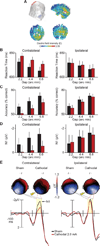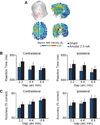Electrical Stimulation of Visual Cortex Can Immediately Improve Spatial Vision
- PMID: 27374337
- PMCID: PMC4961578
- DOI: 10.1016/j.cub.2016.05.019
Electrical Stimulation of Visual Cortex Can Immediately Improve Spatial Vision
Abstract
We can improve human vision by correcting the optics of our lenses [1-3]. However, after the eye transduces the light, visual cortex has its own limitations that are challenging to correct [4]. Overcoming these limitations has typically involved innovative training regimes that improve vision across many days [5, 6]. In the present study, we wanted to determine whether it is possible to immediately improve the precision of spatial vision with noninvasive direct-current stimulation. Previous work suggested that visual processing could be modulated with such stimulation [7-9]. However, the short duration and variability of such effects made it seem unlikely that spatial vision could be improved for more than several minutes [7, 10]. Here we show that visual acuity in the parafoveal belt can be immediately improved by delivering noninvasive direct current to visual cortex. Twenty minutes of anodal stimulation improved subjects' vernier acuity by approximately 15% and increased the amplitude of the earliest visually evoked potentials in lockstep with the behavioral effects. When we reversed the orientation of the electric field, we impaired resolution and reduced the amplitude of visually evoked potentials. Next, we found that anodal stimulation improved acuity enough to be measurable with the relatively coarse Snellen test and that subjects with the poorest acuity benefited the most from stimulation. Finally, we found that stimulation-induced acuity improvements were accompanied by changes in contrast sensitivity at high spatial frequencies.
Keywords: direct-current stimulation; electrophysiology; spatial vision; visual acuity.
Copyright © 2016 Elsevier Ltd. All rights reserved.
Conflict of interest statement
Figures




References
-
- Hamill MB, Koch DD. Refractive surgery - the cutting edge. Nature Medicine. 1996;2:640–741. - PubMed
-
- Palmer SE. Vision science: Photons to phenomenology. Cambridge, MA: Bradford Books/MIT Press; 1999.
-
- Dolgin E. The myopia boom. Nature. 2015;519:276–278. - PubMed
-
- Dutton GN. Cognitive vision, its disorders and differential diagnosis in adults and children: knowing where and what things are. Eye. 2003;17:289–304. - PubMed
Publication types
MeSH terms
Grants and funding
LinkOut - more resources
Full Text Sources
Other Literature Sources

